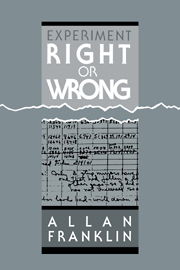Book contents
- Frontmatter
- Contents
- Preface
- Acknowledgments
- Introduction
- I EXPERIMENT AND THE DEVELOPMENT OF THE THEORY OF WEAK INTERACTIONS: FROM FERMI TO V-A
- II TOWARD A PHILOSOPHY OF EXPERIMENT
- 6 Experimental results
- 7 The roles of experiment
- 8 Do mutants have to be slain, or do they die of natural causes? The case of atomic parity-violation experiments
- Conclusion
- Appendix
- References
- Index
8 - Do mutants have to be slain, or do they die of natural causes? The case of atomic parity-violation experiments
Published online by Cambridge University Press: 15 September 2009
- Frontmatter
- Contents
- Preface
- Acknowledgments
- Introduction
- I EXPERIMENT AND THE DEVELOPMENT OF THE THEORY OF WEAK INTERACTIONS: FROM FERMI TO V-A
- II TOWARD A PHILOSOPHY OF EXPERIMENT
- 6 Experimental results
- 7 The roles of experiment
- 8 Do mutants have to be slain, or do they die of natural causes? The case of atomic parity-violation experiments
- Conclusion
- Appendix
- References
- Index
Summary
In this chapter I will discuss an episode from contemporary physics, that of atomic parity violation experiments and their relation to the Weinberg-Salam unified theory of electroweak interactions. This will continue my discussion of the interaction between experiment and theory and of the epistemology of experiment. It will also explore some of the differences between my view of science and that proposed by the “strong programme” or social constructivist view in the sociology of science.
This strong programme view has been summarized by Trevor Pinch.
In providing an explanation of the development of scientific knowledge, the sociologist should attempt to explain adherence to all beliefs about the natural world, whether perceived to be true or false, in a similar way
(Pinch 1986, p. 3).What is being claimed is that many pictures [emphasis in original] can be painted, and furthermore, that the sociologist of science cannot say that any picture is a better representation of Nature than any other
(Pinch 1986, p. 8).A central feature of this view is that change in the content of scientific knowledge is to be explained or understood in terms of the social and/or cognitive interests of the scientists involved.
There is a sense in which I am in agreement with this symmetrical view. The evidence model I have suggested explains adherence to scientific beliefs in terms of their relationship to valid experimental evidence.
- Type
- Chapter
- Information
- Experiment, Right or Wrong , pp. 162 - 192Publisher: Cambridge University PressPrint publication year: 1990
- 1
- Cited by



